An invention very safe in Spain
Thursday, October 31, 2013
Some Engineers from Valencia (Spain) have created a smart carpet to prevent theft, especially in stores.
Now I am going to show you a video, which explains you the invention better:
http://www.rtve.es/alacarta/videos/telediario/ingenieros-valencianos-crean-alfombra-inteligente-para-evitar-robos/2112234/
The commentator says: "If you are a thief and steal at this store aims, know that they will catch you.The doormat discrete hides a thin antenna that detects each of the garments that passes overhead. The device, also, is detailing all the features of the product subtracted".
Javier Muñoz (Director of TAG INGENIEROS): "As we have identified the garment, we know that we are stealing, but we know what we are stealing clothing, uniformly.Then from there, we can decide what starring do, as a function of the value of that garment".
The commetator: "Each tag has a chip that prevents anti-theft uncomfortable skewers. Those who use the system, say that streamlines work: it allows doing the inventory of 9000 clothes, say, in three-quarters of an hour".
Marta Chova (proprietress of "TRASLUZ"): "Every month we do an inventory, then, we already control ... because if indeed there has been some theft or not, we do not need reach the end of season, when we do return, to know it".
The commentator: "For its creators, the challenge has been to reduce the thickness of the antenna and increase your endurance".
Toni Tortosa (Developer of the anti-theft system): "we had to find a material ... in this case rubbery ... in order that it was wrapped and also it had its protections .. at the moment you set foot, logically not break it...".
The commentator: "This Spanish invention is already exported to six countries of the European Union .... and 12 High Couture firms use it in their stores, but their customers do not know it".
I am sure that in Spain there are very smart and well prepared people.
Till soon, kind regards,
Luis.
Sponsored by Costaluz Lawyers.
Please click down here:

 0
Like
Published at 12:30 PM Comments (0)
0
Like
Published at 12:30 PM Comments (0)
Whitegarlic in the Southern Spain
Monday, October 28, 2013
The AJOBLANCO (WHITEGARLIC) is a typical food from Granada, Jaén, Córdoba, Málaga and Almería.
This food spends 20 minutes to be cooked.
These are the ingredients (for 4 persons): 200 grams of bread crumbs. 250 gr. of tender almond. 1 clove of garlic. Virgin olive oil. Sherry vinegar to taste. Salt. For the garnish: 200 gr. of green grape. 200 gr. of good sliced ham.
First of all, soak the crumb with water and leave covered in the fridge for about an hour, so that the soaked uniform. Meanwhile, we will peel the green almonds. Next, we will take the peeled almonds, bread and garlic in a blender cup and go grinding at full power; when we have a smooth paste, pour the oil into yarn, slowly grinding nonstop, until the texture desired (ideally, it is a little thick, but not much). We put a pinch of salt and vinegar and chilled in the refrigerator, at a minimum two hours.
Before going to put the food in the plate, deseed the grapes, cutting them in half and removing the seeds.
We pour the “ajoblanco” into four bowls, put up grapes, ham and ended up spraying with a little oil.
And this one should be the result:
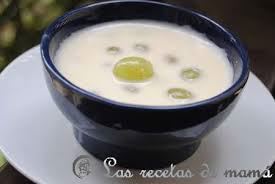
Ajoblanco.
I hope that you have liked this dish.
Till soon, kind regards,
Luis.
Sponsored by Costaluz Lawyers.
Please click down here:

 0
Like
Published at 10:56 PM Comments (0)
0
Like
Published at 10:56 PM Comments (0)
Swimming with tuna in Spain
Friday, October 25, 2013
Today, I want to show you a new documentary of the program “Spain flush with sky”. This one talks about the proyect “Capture tuna over 200 pounds”, by the cousins Balfegó. You will watch to Francis Lorenzo (the presenter of the program) swimming with tuna:
http://www.rtve.es/alacarta/videos/espana-a-ras-de-cielo/espana-ras-cielo-francis-nada-entre-atunes-mas-200-kilos/2088747/
The cousins Balfegó belong to five generations of fishermen, who have revolutionized the world of tuna.
Francis Lorenzo: “Today is a special day, because it is dedicated to the orders,that they have confirmed for the week. The tuna, that are caught on Monday, are an auction of Japan, USA, Korea and Brazil, on Wednesday.......... And after what the Balfegó cousins have told me , I want to see in person how to catch these fast fish, which can swim up to 70 kilometers per hour. My guide in this adventure will be Toni, a lover of the sea, who has spent half of his life to breeding and fishing for these amazing animals”.
You can read on the image of Toni: Toni López. Head of Operations.
Francis: “And when we have a piece, that we want to capture, the key is how we will kill it, right?”
Toni Lopez: “Yes, the key to the fish with the highest quality out is how to die, the fish have to die without stress, it goes swimming normally and then die. We have two or three shooters, who shoot fish, shoot the tuna in the head”.
Francis: “And then what happens: that if they die so and are not aware, the flesh remains intact - say - and product maintains the highest quality?”
Now you can read on the image: This year the maximum quota of bluefin tuna fishing is 1,140 tons.
Toni: “Indeed. If the fish is stressed, if not die like it has to die, it exchanges: the red and the texture would be totally different: it would be brown, I would not have colored”
Francis: “But from where they come…”
Toni: “We the capture….normally we make the capture at the south of the Balearic Islands”
Francis: “How do you bring them up here, to the pool?”
Toni: “We bring in tow, in transport cages, which you will now see, in some pools of 50 meters in diameter; very slowly, so that the fish does not get damaged”
While Toni was talking about capture, you can read on the image: Tuna two weeks traveling speed of 1.8 miles per hour.
Francis: “Well ... And what I am going to find, in water?.......”They say that really imposes, right?, I mean that is beautiful but ...”
Josep María: “They are big animals, they swimm quickly and they pass very close to you. It strikes you at first; but then you see that ... no problem”.
While Josep Maria was talking about tuna, you can read on the image: Josep María Sáez. Diver.
Francis: “I think I am going to try it. I hope to catch one tuna of these with 500 kilograms me alone…..to see what happens….”.
Francis: “We arrived at the fish farms, brimming with tuna; what I did not expect is that Toni invited me to swim with these giants, which can weigh up to 500 kilos”
You can read on the image: The largest tuna in the fish farm weighed 590 kilos .
Francis: “The truth is tah so, at the beginning, it gives some qualms.But, well…it is an opportunity , that I can not waste….. Piece of tuna, with whom I am meeting .....!..... but I am going to do it, Toni ....., I am going to do it”.
Toni: “You will enjoy it…, you already will see it”
Francis: “But, Did you see the speed they carry on?”……….
Francis: “They are bugs of 300 kilos and if I am honest, I am a little scared”……………………
Francis is swimming…..
Francis: “They are some vermin of this size…..”
Toni: “How had it go?”
Francis: “Come on, mate ... How is this…. .. it is amazing!....But what bugs….!!, Are not them?..But so…of 500 kilos….One “Miura” (a famous livestock in Spain. Its bulls are very very dangerous) just passed by me…”
Now you can read on the image: Divers grouped in one area of the cage, the tuna that they will catch that day.
Francis: “What is the most delicate moment?, When you were running the team I have seen how you sent floats, how you placed all your people in the water ...”
Toni: “What we are doing right now: put the fish in the "killer", in this net”
Francis: “Now divers are working under water to take them away there, right?, what they are dragging”
Toni: “Yes, yes”
Toni: “Francis….we have already closed and, according to the divers tell me, I think we will have here 2 fish, rising to 300 kilos”
Francis: “So now check fishing they have there, if they have the required size, the size that you have ordered and, if so, begin the process of killing and capturing, to upload the ship. Let's see how much tuna have gotten into this site”
Toni: “You go down half of the balloons and we start”….. “First pass bigs, as not to stress”
Now, you can read on the image: Each day they will use 120 tons of sardines and mackerel for tuna feed.
Toni: “They just shoot, Did you listen?, Look, there it is”
Francis: “Yes…there one comes, there one comes…one of the bigs”
Francis: “How many kilos will have this one,Toni, more or less?
Toni: “260”…” Do we weigh it?
Francis: “But, we are going to regret it, to see how the thing is; but it is a real bug. Toni was saying that this would be at about 260 ... weighs 276 kilos, going, wrong in 10 pounds ..., nothing, nothing, this is nothing, it is a good accuracy. Hey, it is a good bug, is a good bug "
Toni: “Now remove the viscera .... Here we look if it is male or female .... – Toni´s companier says a male -- ...., all these data the aim ...... And now, Ramon, give me the tail, when you finish .. and now this here tail sample is analyzed on the ship and here we take the percentage of fat ...; depends on the percentage of fat you have, it is going to one country or another, a client or another ... and normally, the highest percentage of fat is going to America, to the United States”.
Francis: “Thanks to a code label, a diner can know the whole path that will eat tuna: when and where they fished it, in what pool it was, how much of what was weighed and fed”…..”Well…what an experience…!”
Toni: “What do you think?”
Francis: “Ohh…awesome…It is amazing what the tuna .., I was surprised .... I have taken some scare ... also I have to say it ... hehe ... Has there been any time .... are some bugs, some bugs of 400 kilos .., that go through your hand and suddenly you say ....”
Manel (a fish exporter): “Noooo, harmless, completely .... they start eating next to you and when they see that there is enough distance to stop by your side,…..”
Francis: “And I have been amazed ... watch it: young people who are working, it is very well, and then you just caught, all prepared and it is in the world tomorrow .....”
Pere (a fish exporter, like Manel): “Yes…, this evening it goes out, at 5 in the afternoon and leave from Japan to the United States ....”
Manel: “It has its air ticket”
While they were talking about te trip of tuna, you could read on the image: Pere and Manel export red tuna to more than 25 countries.
Francis: “It has its air ticket…What a good loving so to a fish, Right?. That you love tuna and you can live from it …I feel great…I will from now eat more tuna..jeje”…”The last process is the cutting of tuna; a good cut is essential to get all the meat in one piece, which sells for 39 Euros a kilo ... The thing that attracts attention, is opening the tuna, is the resemblance to a good rack of veal ... in less than 24 hours, the tuna can be enjoyed anywhere in the world”.
I hope that you have test any tuna from Spain sometimes.
Till soon, kind regards,
Luis.
Sponsored by Costaluz Lawyers.
Please click down here:
http://www.costaluzlawyers.es/
 0
Like
Published at 11:45 PM Comments (0)
0
Like
Published at 11:45 PM Comments (0)
The Forest of Irati , Spain
Wednesday, October 23, 2013
One more time, I want to show you a documentary about an area in the North of Spain.This documentary can be watch through the tv program “España a ras de cielo” (“Spain flush with sky”).This documentary is named “La Selva de Irati” (“The Jungle of Irati”):
http://www.rtve.es/alacarta/videos/espana-a-ras-de-cielo/espana-ras-cielo-selva-irati/2067211/#aHR0cDovL3d3dy5ydHZlLmVzL2FsYWNhcnRhL2ludGVybm8vY29udGVudHRhYmxlLnNodG1sP3BicT0yJm9yZGVyQ3JpdGVyaWE9REVTQyZtb2RsPVRPQyZsb2NhbGU9ZXMmcGFnZVNpemU9MTUmY3R4PTY4MjkwJmFkdlNlYXJjaE9wZW49ZmFsc2U=
The presenter of the program (Francis Lorenzo) explain us how is Irati:
Francis Lorenzo: “We are flowing over the Navarre Pyrenees, near the border with France. We are in the Irati Jungle: the largest Forest in Spain, a green mantle of 17,000 hectares, which is two times the size of the city of Barcelona”.
Now you can see a message on the image. It says: In Europe only Germany's Black Forest is bigger than Irati.
Francis Lorenzo: “Aizcoa is one of the four valleys of this forest. Here we expected Josetxo, a man carrying 60 years dedicated to a little-known business: wood. With him, we will discover how trees which have more than 20 meters high are cut down”.
Now you can read: Josetxo Telletxea. He is dedicated to wood since he was 15 years old.
Josetxo Telletxea: “We are going to cut peak here more than two thousand trees, with ore measuring of 1.500 cubic meters approximately. The lot was removed in auction: they make an Auction, which call for the people dedicated to wood and it is give to the highest bidder”.
You can read on the image: At an auction he (Josetxo) paid 32000 Euros for this lot.
Josetxo: “Tree goes!, ja ja”.
You can read on the image: The beech wood is used to make furniture mostly.
Josetxo: “I have been here with wood since I left the teeth, because my father was a timber forest and I left school at 15 years old, 60 years ago, this is the second and will be the third –ñc vf generation of exploiters. I think in Navarra there are none ... none that is third generation. In the 60 years that I know, because here, at this point we are, there would have come on foot, male horses, to do the job ... had no roads, there was nothing and what was done was drag animals. Today we come with a tractor and hooked those 4 or 5 trees and we took a trip””Well I will say that the work of 40 or 50 men, in those days, today is being done with a couple of men or three”.
Francis: “For men like Josetxo, this forest is their livelihood ....”
Now you can read on the image: Carlos, Mario and Javier. Forest Rangers.
Francis: “But the logging can not be uncontrolled; Carlos, Mario and Javier are the rangers, who are responsible for overseeing the logging of these valleys”.
Carlos, Mario and Javier are talking to Josetxo.And Josetxo tells something to Mario –I think--:
Josetxo: “Hey, I have seen a tree that I need; let´s see whether you can mark it for me….”……… “This is the tree”.
Mario: “What action they ask you?”
Josetxo: “Well, they ask the tree has 8 meters…, but it must have 1´70 circumference”
Mario: “74 and 76….75, Average diameter is 75”…”But, we mark it…. They always have to cut with the mechanical saw above we have given stamp down there.Then, So, although we come to the days or whenever, we note that the brand has to be in the "stump", which stays ".
You can read on the image: It is common eyeballing the height of the trees.
Josetxo: “But…12 meters may it take…?.
Mario: “Well I was going to point 13 ... 13 and a half”
Josetxo: “And from there up .... it may take about 5 meters ....”.
Now, you can read on the image: The rings on the base indicates the age of a tree.
Mario: “Do you come there, Josetxo?”
Josetxo: “Yes”…” It is calculated standing 12 meters…….from the first branch”
Mario: “13 meters till the first branch”
Josetxo: “13 meters, yes, I have said 12 and you 13, but very well”…….” Now let's measure the burning zone, the length that is from there forward”
Mario: “Eight more meters”
Josetxo: “8 meters and 21 meters of wood, 21 meters the total length of the tree, which is productive. Nothing ... till another day, and will let you know”.
Well, here is finished this documentary. I hope that you have enjoyed.
Till soon, kind regards,
Luis.
Sponsored by Costaluz Lawyers.
Please click down here:
http://www.costaluzlawyers.es/
 0
Like
Published at 12:47 PM Comments (3)
0
Like
Published at 12:47 PM Comments (3)
Two important events in the Spanish Gastronomy
Friday, October 18, 2013
Two important events in Spanish Gastronomy held these days, until the end of the month: the third edition of "Tapapiés" in Madrid, and the "Txapelketa" in Bilbao. "Tapapies 2013" takes place in the neighborhood of Lavapies in Madrid (is a gastronomic tour). And "Txapelketa" held in Bilbao and is a contest of "Spikes".
In the neighborhood of Lavapies is celebrated "A multicultural Route of cap" and in Bilbao, the Contest "Pintxo Txapelketa”.The Route of Madrid, the last year, attended by more than 20,000 people.In Bilbao, they have 16 editions and this year are presented 118 different "Pintxos".
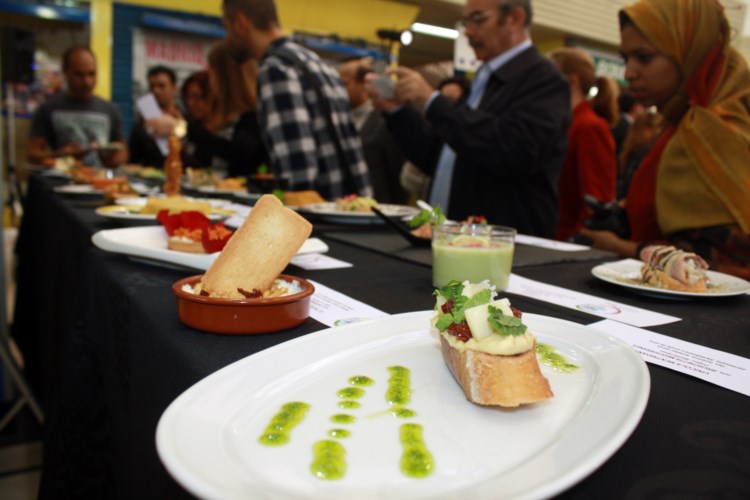 Inauguration of the Route "Tapapiés", Madrid, Center of Spain Inauguration of the Route "Tapapiés", Madrid, Center of Spain
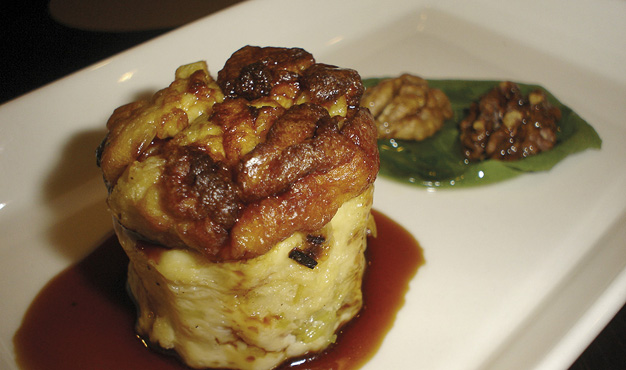
Tapa from BORODIN Bar

Tapa from Antigua Taqueria

Tapa from LA AMPARITO
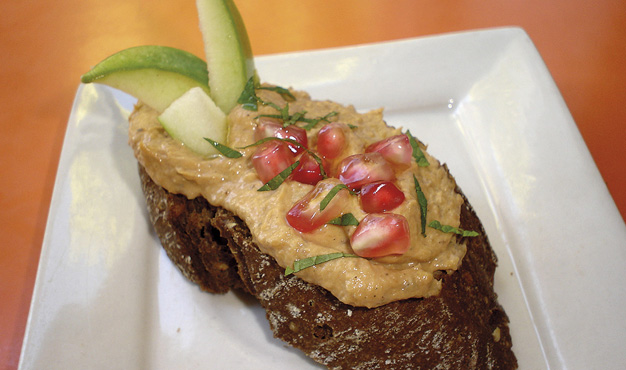
Tapa from LIBRERIA DE LAVAPIES
The Contest in Bilbao is not a multicultural Route, like in Madrid, because in Bilbao they celebrate a very old tradition, around the “Pintxo = Pincho” (Bite). The Contest has several categories: Award for Best Bite, Award for the Best Establishment, Award for the Most Popular Bite and there is a new category that is: the Award for Best Bite made with a certain product, which this year is the squid.
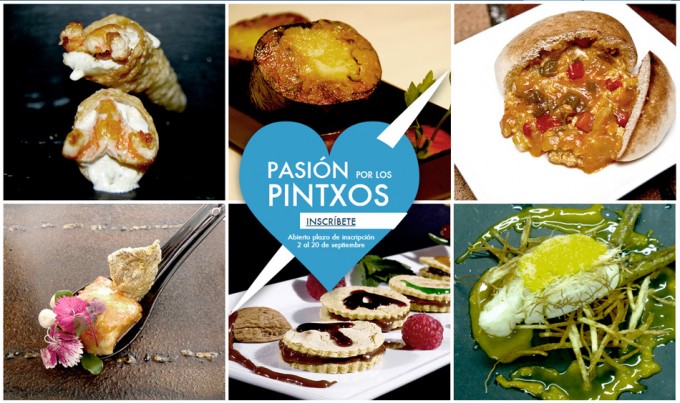 "Pintxo of squid", Bilbao, Vizcaya, North of Spain "Pintxo of squid", Bilbao, Vizcaya, North of Spain
Lavapiés is a neighborhood, few hundred meters from the Puerta del Sol, in the center of Madrid. In recent years has been filled with people from the Emigration, which has developed around the Trade and Hospitality.
In Bilbao there are very different “Pintxos”. Some of them have very curious names, for example: “Castaña de Lasaña” (Chestnut of Lasagna). But this year the “star pintxo” is the pintxo of squid; therefore, these are some of the names: “Squid confit with sferification in ink sesame snack with consomme of txacolí (chacolí)”. And also there is food with humor; so, in the bar “Pintxo and White”, there is a pintxo very simple, named: “Squid and egg”.
The route “Tapapiés”, in Madrid, will happen from this weeken till the next one –all the days--. And the contest “Txapelketa”, in Bilbao, will happen this weekend and the next one.
In Madrid, there will be 75 tapas, from 19 different provinces of Spain.
I hope that you can go to Madrid or to Bilbao the next year.
Till soon, kind regards,
Luis.
Sponsored by Costaluz Lawyers.
Please click down here:

 0
Like
Published at 8:07 PM Comments (1)
0
Like
Published at 8:07 PM Comments (1)
Synonyms and Antonyms in Spanish 2
Friday, October 18, 2013
ABASTECER (SUPPLY)
Sinónimos: Proporcionar, surtir, proveer, equipar.
(Synonyms: Provide, supply, provide, equip).
ABATIR(SE) (BEAT DOWN)
Sinónimos: Desalentar, desanimar, decaer, descorazonar.
Synonyms: Deter, discourage, decay, discourage
Antónimos: Animar, estimular, apoyar
(Antonyms: Encourage, encourage, support.
ABDICAR (ABDICATE)
Sinónimos: Renunciar, dimitir, abandonar
Synonyms: Relinquish, resign, give up.
Antónimo: Aceptar
Antonym: Acept.
ABERRACION (ABERRATION)
Sinónimos: Desvío, vicio, perversion
Synonyms: Turnout, vice, perversion.
Antónimos: Correccion, virtud
Antonyms: Correction, under
ABIERTO (OPEN)
Sinonimos: Despejado, desembarazado, expedito
(Synonyms: Clear, rid, expeditious)
ABIGARRADO (MOTTLED)
Sinónimos: Sobrecargado, barroco, estridente
(Synonyms: Overloaded, baroque, shrill).
Antónimo: Sobrio
Antonym: Sober.
ABISMO (ABYSS)
Sinónimos: Sima, precipicio, barranco,despeñadero
Synonyms: Sima, cliff, cliff, cliff.
Antónimos: Llano, cumbre, cima.
Antonyms: Flat, summit, summit.
To be continued...........
Till soon, kind regards,
Luis.
Sponsored by Costaluz Lawyers.
Please click down here:

 0
Like
Published at 12:29 AM Comments (0)
0
Like
Published at 12:29 AM Comments (0)
How lights Spain?
Wednesday, October 16, 2013
Today I want to show you an interesting part of the program of TV, “Spain flush with sky”; this one teach you how lights Spain.
Here you have the video of the program “ Spain flush with sky”:
http://www.rtve.es/alacarta/videos/espana-a-ras-de-cielo/espana-ras-cielo-como-se-ilumina-ciudad/2054465/
Francis: “The sun is about to set and the night takes hold immediately of the city. In your homes, you give it to a switch and then light up the kitchen, the living room ... but How a big city lights?, Is there a person in charge of activating a device?. We are going to see that: of how it illuminates a city. Illuminate a big city like Madrid is very complex, so there are experts who devote half a lifetime to study it.If I want to know how to light the cities, there is only one person who can tell me. Which part is the first to be turned into a city, such as Madrid?”
Alejandro Sánchez (University Professor): “The first thing that usually illuminate are private facilities, that have a lighting system a bit archaic, but that more or less works and is a clock, which at a certain time, you set it and goes on”.
Francis: “And tstreets or the more important city centers How to go?”
Alejandro: “The most common is to have a special sensors to detect how much light there is, well, hey, will darken and then sends the signal to begin to illuminate. And another, is a type of watch, special, called "astronomical clock" which calculates what is the ideal time to start to light streets.Then, you see how lights only what you want and when you want”
Francis: “What are we seeing now?”
Alejandro: “Now we are seeing how the suburbs are very bright, the M-30, however there are other areas of Madrid, which still is not lit, because they have the astronomical clock, which still has not sent the signal lights”.
Francis: “And goes through phases…”
Alejandro: “Sure. Then, depending on what kind of watch they have, are illuminated some zones or other first”.
Francis: “I called attention to the bottom is on and yet is off around”
Alejandro: “We have the same street, with different phases”.
Francis: “What happens?”
Alejandro: “It is due to these different watches, which I mentioned. For example, we could imagine that this first part is with a clock, an hour, plop, at that time is on”
Francis: “Can we see now how this going on?”
Alejandro: “Yes, also looks like a different color ....it is because.thay are heating lamps and take a while”
Francis: “And there is a common point in the lit monuments in Madrid, for example "
Alejandro: “Yes, More or less at around 10 pm is programadio, to illuminate the monuments: La Almudena, Royal Palace. La Torre Picasso”.
Francis: “What is the trend in the world with this about light?
Alejandro: “That the lighting fits what is really happening on the street: no people, then the lighting is minimal and where there are people, which is maximum, that is a smart lighting "
Francis: “Well, I was very clear that there is nobody who press a giant switch to light up a city and that cities do not light all at once, Spain does not light up all at once, but it goes in phases , now we can say that Madrid is 10 pm and that everything is illuminated”….” We have seen how, thanks to technology, our homes, streets and cities remain lit when the sun sets in the West. Spend more or less light, the Spanish are nocturnal by nature: when we go out, at whichever hour, we always find people on the street. A recent study from Nielsen, conducted among 15,000 Internet users, confirms that the Spanish are the ones who later fell asleep in Europe”.
I hope that you want to come to Spain in order to confirm it.
Till soon, kind regards,
Luis.
Sponsored by Costaluz Lawyers.
Please clic down here:

 0
Like
Published at 12:42 PM Comments (0)
0
Like
Published at 12:42 PM Comments (0)
Colors for Spain
Monday, October 14, 2013
One of the most bohemian buildings of the capital of Spain, the Barley Market, will undergo a major transformation. And that is, after almost 140 years of history, both its façade, as part of its inside, will be filled with color thanks to “Boamistura” art collective, that next October 16 will terminate its involvement in this landmark building, making it one of the older urban art world, and the largest in Spain, which have covered 6,000 square meters in area and have been used 2,000 kilograms of paint, 40 rolls extendible and around 1,000 hours of work by a team of 15 people, who worked from dawn to dusk during this time, not understanding Sundays or holidays.
BOAMISTURA consists of five young locals , from the area of Alameda de Osuna , sharing from their teenage passion for painting , and what began as a group of kids graffiti fans ended up being an art collective that has worked in cities like New York , Venice , Cape Town , Manchester and more. Javi , is an architect and one of the artists in this group consists of a graphic designer, a graduate in Fine Arts or civil engineer. From their point of view, the Barley Market was the place to convey optimism , "this market is one of the most emblematic buildings in the center of Madrid , especially in the neighborhood where it is, La Latina, and bohemian atmosphere brings more charm yet, and all this combined with the process of decay in which it was made to give you the ideal point of optimism for this initiative” , --he adds-- “It had all the sense in the world to change and give a touch of color to this neighborhood “. Javi believes that the capital still lacks a few steps forward as far as urban culture is concerned, "Madrid is still at a slightly hostile city to work , every time we want to take a project forward obstacles we encounter perhaps other cities more liberal or a more open mind about these issues we are not” . Nevertheless , he and his colleagues are very excited with this renovation.
The imposing dome of this building are the key element of this great mural, occupying 4860 meters square and each is painted a very striking color , “We wanted to reflect the foods that you can see on market stalls , reflect on to-day activity”. The environment is not invited to something else, because from the top of the building you can make out the domes of important places such as the Church of San Francisco El Grande , Church of St. Andrew , and even a little further away from the cathedral domes of La Almudena and the five of the Barley Market passed quite unnoticed , until now. For Boamistura it was essential to give them the role yhat they deserved : " The impact on the landscape is very important. Not only are seen from the street , creating lighting effects, colors and shades will also be present and very visible in the life of the roofs , bars and terraces of La Latina”. But Boamistura could not leave this great work without giving one of his most characteristic touches , and the colors of the domes serve as support so you can read the word "Color" , written in white by Anaformismo (It is a perspective effect used in art to force the viewer to a certain point of view or privileged preset , from which the element takes on a proportionate and clear) technique , which consists that this word can only be seen from a particular point of view , in this case from the dome of blue, from other points is only abstract white lines .
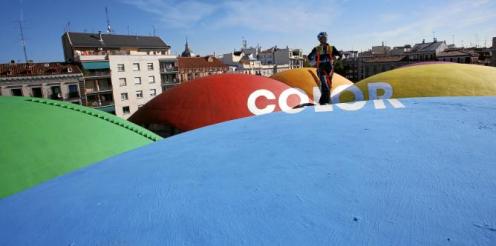
The domes of the Barley Market, Madrid, Spain
Lastly, outside the market, where the front door, you can read the main motto of this initiative: "Fill color life" in big letters, bright colors, how could it be otherwise way to convey optimism to all who pass by.
But not only outside the Barley Market will be remodeled, inside also will experience a radical change and will have a public open space to be dedicated to the different expressions of optimism. The activities can be made there will be related to music, film or fashion design among others, will be a showcase for all young entrepreneurs who want to show their ideas and projects, so we can bring them to reality in a time more complicated than normal. Also, give lectures and talks to people and groups of people who have managed to break into one of these fields and who want to share their experience. All activities which are organized there , will be open to the public, even before the expected demand will have a limited capacity.
You have to go there in order to see it personally!.
Till soon, kind regards,
Luis.
Sponsored by Costaluz Lawyers.
Please click down here:

 0
Like
Published at 11:22 AM Comments (0)
0
Like
Published at 11:22 AM Comments (0)
The Red Garlic in Spain
Saturday, October 12, 2013
The Red Garlic –although the real name is not “Red….”, but “Colorado….= Colorado”, that is same than Red.
This kind of food is a typical food of Almería, but also of Cordoba (both in the South of Spain). Also in Málaga.
It is a dish that takes mashed potatoes, dried peppers, tomatoes, cumin and usually takes fish -- usually cod--. And it is usually eaten in Easter Week.
These are the ingredients (for 4 persons): 1 kg of potatoes. 1 onion. 2 cloves of garlic. 2 dried peppers. Ground cumin pinch. Virgin olive oil. Sherry vinegar to taste. 200 grams of without salt cod.
First of all, peel the potatoes , the onion and cut both in crude dice , put them in a pot covered with water and salt, and cook 20 minutes, then , we drain everything. While the potatoes are cooked , we put oil in a pan to heat and fry the dried peppers and garlic cloves, peeled, take lots of color. When everything is ready , we put in a bowl to mash the cooked potatoes and onion , peppers and garlic fried. We grind all very well , until a thick puree , add a little of the cooking water from the potatoes and , without stop moving , come pouring oil on linen , as if it was a mayonnaise. Once the texture is desired , add the cumin , vinegar, add salt , if required , and store in the refrigerator at least two hours.
With a carving knife , very sharp , we take the piece of cod and cut it into very thin slices . We discard the skin .
Presentation: in four bowls , put the " Garlic colorao " cold , place it over cod and sprinkle slices with olive oil .
Tip: If you have time , it is always better to buy cod salting and desalting at home, because if not used, enduring several months in the fridge . To desalt the cod properly, cold water to cover and leave in the fridge for 24 hours , changing the water every 8 hours.
Well, but this one must be the result:
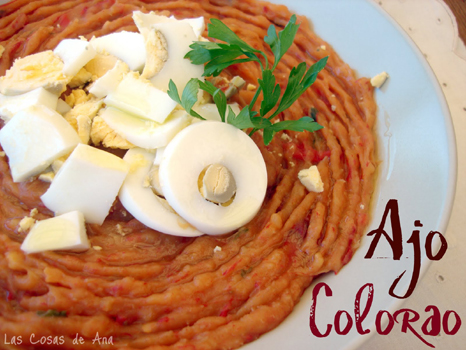
Ajo colorao (Red garlic)
I hope that you want to try it.
Till soon, kind regards,
Luis.
Sponsored by Costaluz Lawyers.
Please click down here:

 0
Like
Published at 12:35 AM Comments (2)
0
Like
Published at 12:35 AM Comments (2)
The Escorial, Spain, from sky
Thursday, October 10, 2013
This is the program of Tv “Spain flush with sky” and now dedicated to the wonderful construction: the Monastery of San Lorenzo of El Escorial, that is 47 kilometers from Madrid.
This is the video of this program:
http://www.rtve.es/alacarta/videos/espana-a-ras-de-cielo/espana-ras-cielo-monasterio-san-lorenzo-escorial/2040535/
Francis Lorenzo (the presenter of the program) says: “From this “chear”, it is supposed that Felipe II (Philip II) watched the construction that four centuries later was declared a World Heritage Site. At that time there was not a policy of preservation of these wonders ...... but now yes, and, thanks to that, Spain is the second country with more world heritage of the planet. Specifically are 44 the cultural properties, monuments and natural sites that UNESCO has recognized of our country”.
Francis follos saying: “Our journey begins at only 50 km from Madrid. There is the Royal Monastery of El Escorial, which was declared a World Heritage Site in 1984. Each year it hosts more than half a million visitors”.
Over the image, you can see a sign that says: the work of the Escorial lasted only 21 years.
Francis says: “After, we will tell you who are the tenants of these nearly thirty-five thousand square meters; but now we will meet Juan Ignacio Cuesta (a scholar who knows all the secrets of El Escorial), and we will do as Philip II: from heights”
Juan Ignacio: “The dimensions of the Monastery are absoultly spectacular: it takes about thirty-five thousand square meters, approximately, which comprises the four main towers: the tower of the Cierzo, of the North, of the Ladies and of the Garden”.
Note: while Juan Ignacio is talking about the towers, you can see three signes which say: Library, Library, Church, 92 meters high.
Juan Ignacio: “After, it has the Dome and two bell …and formed inside barracks: one belongs to the Closing of the Monks and the College currently Alfonso XII”.
Francis: “Felipe II wanted that The Escorial was a Pantheon where they would rest all the Kings of Spain. The last King to find rest, in the Monastery, was Alfonso XIII, whose remains returned to Spain in 1980”.
Note: While Francis was explaining about the Kings in Spain, you can watch the sentence: 12 monarchs are buried in the Pantheon of Kings.
An announcer on Spanish Television says: “After the funeral, the coffin of Alfonso XIII is transferred to the Pantheon of Monastery. The King of Madrid, finally, rests in his land .., with his parents and ancestors in the Crown of Spain”.
Juan Ignacio: “We have two locations: one is bound logically to Juan Carlos and other one is intended for Sofía, his wife, and then we do not know what will be done, because there is no more room for more Kings there".
Note: You can watch a sing that says: Philip II was a big fan of relics, and so here are saved over 7000.
Juan Ignacio: “Today everyone can see the Monastery inside and you can visit it, but in time of its founder, could not get more than he and his monks and whether a personality, no one else. And so it was for a very long time, almost until the twentieth century Only one visit allowed check that this is one of the great wonders that man has conceived, his tenacity, his effort, and of course, with its money”.
Francis: “The most extraordinary thing of The Escorial is not that it it the largest Royal Monastery of Spain, but it also is inhabited for 450 years. We walked into the private part of Monastery, closed to the general public. Only people who inhabit these walls know their mysteries. But ... Who live on this monument, considered for years, "the eighth wonder of the world"?”.
Antonio Iturbe (Prior Father Augustine): “We are around one hundred people who live here: the Children of the Choir, who sing in the choir, in the Basilica. After, there is a number of students of Theology and then is the Community itself. We are Priests and have the whole organization and all the work of this Monastery”.
Francis: “Prior Father leads us to contemplate the best views from the tower of the Chemist of the Monastery…. We are lucky because, being in a private area, they may not be enjoyed by visitors”.
Antonio Iturbe: “I every morning when I wake up, I open my balcony and I see this same ... and is a joy to enjoy this view of the Escorial”….”The year 1885, we the Agustinian took over the Monastery of The Escorial; but we are Friars, living in a Monastery; although we move much out, because that was the purpose of the mendicant orders: being in the village, with the people and for the people”…. “Living here makes you unravel the true soul of the Monastery. You have to live, to be here and enjoy this, and it is, as I say, a privilege and a honey to may live here”……” In this Basilica have been married important people and people who are not so important, there is everything”.
Francis: “One of the most talked weddings occurred in 1970: Rocío Durcal and Junior got the "I do" in front of hundreds of attendees”.
Archive NODO (News Documentary): “She wears a dress, Princess line, long sleeves and narrow tail flared skirt and waist part. In the preparation of the veil, they were employed more than 4 yards of tulle…. One last requirement: spouses and witness sign the Marriage Certificate…. To the newlyweds everybody will develop all kinds of adventures”.
Francis: “At weddings celebrated in the Basilica of San Lorenzo, one of the most anticipated moments is a performance by the Choir of the Schola cantorum: fifty children, known worldwide for their virtuous voices”
A message on the image: This choir was founded in the sixteenth century.
Francis: “But what is not known is that these children live, together with the Friars, in the monumental Monastery. Who are they?, What qualities do they have?, How these children are chosen?”
Another message on the image: 51 children make up the Choir.
Jose Maria Herranz (Director of the Schola cantorum): “For a child to go to the choir, we have a selected process: we first visit a lot of schools, you select a number of kids, who are invited to some tests, here in the monastery. All these kids have great qualities, both for study and for the music, because life is very demanding in the choir: they have a very full schedule, and good, they are very happy, but they have a lot of work and not all children are worth for this”.
Jose María: “Good afternoon”
The children: “Good afternoon”
Jose María: “Here I introduce to younger children the Schola cantorum: these have arrived 15 days ago and already have you heard them singing. Here studying music theory and prepare to join the Choir”.
Francis: “Newcomers Children receive their first lessons in music. With the passage of time, the best of them will be part of the Choir and sing for half the world; only they know the effort they do, to keep in the Choir”.
A message on the image: They havesong for the Popo Benedicto XVI and in 10 countries.
Daniel del Valle, 12 years old: “We do daily one hour of rehearsal and the weekend do two hours and sometimes even more ..... And also devoted considerable time to the study .... It is quite disciplined, but you learn a lot ... And music here is what else there is”.
A message on the image: Children see their parents one day a week.
Alejandro García, 16 years old: “I have been here nine years and I really was not aware that I live in a place that is a World Heritage Site and the truth is that it is a bit like ... Oh, my God ... it is here, in the book of Language, The Escorial ... I do not know .... it's an experience ...”.
Francis: “We have known how live the inhabitants of this monument created by Man”.
The program has finished and I hope that you have enjoyied.
Till soon, kind regards,
Luis.
Sponsored by Costaluz Lawyers.
Please click down here:

 0
Like
Published at 3:48 PM Comments (0)
0
Like
Published at 3:48 PM Comments (0)
Another Spanish sayings and proverbs, 51
Tuesday, October 8, 2013
Here I bring you a very popular spanish saying:
A rajatabla = Strictly
So is how the edge of the hatchet slits (cut) the wooden board: sudden, energetic and rectilinearly.
Also the dictionary says: "Regardless, at all costs and without hesitation".
That is the meaning of this adverbial phrase.
This is an example: "Both orders of superiority as the doctor's recommendations were fulfilled to the letter (strictly)". I think of another example, because, when somebody is making a diet regime and when it is being well done, we say that it's getting "A strictly".
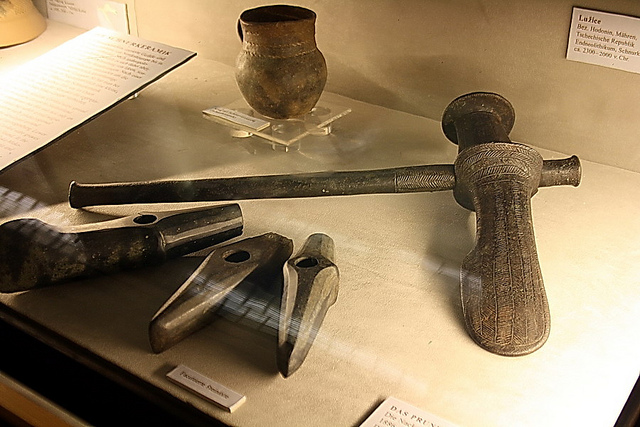
Viena-Wien. Naturhistorisches Museum. Destral, by Pilar Torres, at flickr.com
I hope that you have enjoyied.
Till soon, kind regards,
Luis.
Sponsored by Costaluz Lawyers.
Please click down here:

 0
Like
Published at 11:12 PM Comments (0)
0
Like
Published at 11:12 PM Comments (0)
Spanish Technology to inspect the Metro
Friday, October 4, 2013
The last October-1, in the night, a Japanese delegation was in Madrid to oversee the work of revision of the Metro de Madrid with this new machinery. Metro de Madrid SA is the company managing the review of the various sections of the Madrid Metro.
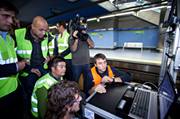
This new machinery has been invented by several Spanish Engineers. And, in Japan, the company than manages the Subway, is interested of buying this machinery.
This machinery automatically collects information by laser sensors to six cameras. Make five times faster essential work that was previously only possible to collect manually.
It is a system developed by the Spanish company Engineering measures, Euroconsult, thanks to an agreement reached by the General Department of Infrastructure with the company, and has had no cost to the Community of Madrid.
It is a data collection device that runs on the tracks and takes pictures automatically by laser sensors, the tunnel and the route for further analysis. For it has six cameras, mounted on a moving vehicle, to take pictures of the track and the tunnel.
These images reflect the state in which it is the design of road and if there is damage in the trains and the passage of time. This information includes, for example, if there are narrowing and widening of the road which could affect the movements or whether cracks have appeared, moisture or breakage of the tunnel walls.
In addition, the imaging allows statistical treatment of these injuries in order to plan the necessary maintenance measures. In this sense, to perform these measurements so periodically, it is possible to analyze of changes over time, allowing to know advance the possibility that defects occur and avoid.
These jobs are critical to the safety and maintenance of the service and therefore take place regularly in the tunnels of the Metro of Madrid within Maintenance work, but manually. The new system allows more effective this work to five times faster. The greater flexibility and speed of this system over manual data takes wing allows insight into the evolution of the tunnels states to process and record information of the inspections for its later analysis.
Remember that this type of data collection task can only be done at night, when the lines of the Metro are out of service, so that the time available is very limited that and speed is, therefore, a great advantage.
I hope many other countries appreciate the good work of our Spanish Engineers and buy this machinery, to improve the infrastructure of those countries.
Till soon, kind regards,
Luis.
Sponsored by Costaluz Lawyers.
Please click down here:

 1
Like
Published at 10:52 PM Comments (0)
1
Like
Published at 10:52 PM Comments (0)
Legal said and done in Spain
Friday, October 4, 2013
In Spain there are widely used legal expressions. For example, one very popular expression is: “Pagar justos por pecadores” (Paying for the sins). Another expression is: “Es major un mal acuerdo que un buen pleito” (A bad deal is better than a good lawsuit).
But a very old and very good expression was said by the Spanish writer, Francico de Quevedo, who said: “Where there is no justice, it is dangerous to be right”.
The most of the expressions have born in historic acts. For example, when we say: “Cargarle el muerto a otro” (carried the dead to other people), it means that, In the Middle Ages, when it appeared the corpse of someone who was very common, especially for diseases, the city of the people were bound by a sanction called "Omicision" to pay, among its inhabitants, the cost of burying the dead then to avoid this, many residents left the dead in other towns at night, to avoid pay. So, they "carried the dead to other people".
Another old expression is: “A buenas horas, mangas verdes”, that means that in 1576, Isabel The Catholic created a body named “La Santa Hermandad”, that was similar than the Guardia Civil today. Police body, similar to the Civil Guard today. They were dressed in a green blouse. At first they began to work very well, because even helped conquer Granada. But over time, the "gangs" are bad people drifted and finally, the term "gang" - because they were 4 by 4 - finished having a pejorative connotation, people said: "Uah petite gang ........!”; when a crime was produced, were always the last to arrive and as his uniform wearing a green sleeves Blouson, people started said: "In good times, green sleeves .....". But when Green Sleeves were late and getting detain someone, taking him to the dungeons; prison is a very modern concept: it dates from the eighteenth century until now, but before he had dungeons, etc beneath castles and that time it was common for people to hold him chained to the wall with iron stocks, called "brete" and that meant that the prisoner was "in a brete," which means "Get into a quagmire of you can hardly get out”.From that comes the expression "Poner en un brete" (To put someone in a brete).
The expression “Estar en Banca rota” (To be in Bankruptcy) comes from Italy, because, In the Renaissance, Florence lenders and other cities, especially in Lombardy, northern Italy, were doing business putting on standing on a wooden bench -- that is why they are called "Bankers", because they placed above a wooden bench -- they were placed on a wooden bench in the streets, to make transactions: they shooted to people, announcing to giving loans, deposits, trading with precious metals, coin changers, and when business has been bad, the city authorities were breaking the wooden benches, literally, that meant that the lender for its clients had had liquidity problems and, as they were breaking the wooden bench, the situation was called "bankruptcy ".
Another famous expression is: “Borron y cuenta nueva” (nothing from the past matters, a new life starts now!) Note: I am sorry but it is difficult the translation.
Well, as I was saying, the expression “Borrón y cuenta nueva” has this story: until Gutenberg invented the printing press, books were copied in manuscript form, by a poor man, who all his life he should be writing with a pen and ink, writing a book. At that time they wrote on parchment - it was a paper that came from the city of Pergamum -. Then, with a sepia ink and charcoal pigments, sharpening a goose pen, again and again, and with that they were copying the words, little by little, being careful not to smearing, because at the time of smearing, and was not worth that original at all, which had to do "clean slate".
Another expression is “Pagar bajo cuerda” (Underhand Pay). Many kinds of punishment; but the most common was the death penalty; there were several types: a cudgel, drowning, suffocation, sawing, nailing, choking, crucifying, beheading, beheading. There are 28 different ways; but the most common was choking. Then, in the past, when you paid with the to pay to the gallows, which makes the law, makes the catch: when a person is condemned to die, hanging from the gallows, which to his family bribed the hangman to the gallows rope smeared with acids, so that when hanging the condemned, the body weight rope broke and so it was said that "they had paid under the rope ". Then, it was thought that if the rope was broken and if the condemned did not die, it had not to die.
The word “Cadaver” comes from the Latin, where it was: “Caedere” , that meant: “fallen”; for a Roman, a person could have three situations: To be fallen –or died--, to be firm –or stand--- and, who were not firm, but were almost firm, were the “infirmes” –from there comes the word “enfermo” (ill).
Now I am going to talk about the Eponyms. Everything starts when the famous word “Moscosos”. Moscoso is an “Eponym”. That means it is a word, turned into noun, from a surname of a person; in this case: of Javier Moscoso was a Minister in the Socialist government of Felipe Gonzalez, who first passed what the "6 days of license or permit for private matters", that no longer want the officials. Well, but like this case, in Spain we have many other cases, where a word come from a surname. Two words are: “Linchamiento” and “Boicot”.
This is the story of “Linchamiento”: Charles Lynch was a Judge of the eighteenth century, in Virginia (USA), who became famous because he created a People's Court, where executed, without trial, without hesitation to all British Army soldiers who crossed his path. As he decided to hang it all seemed suspicious, in the United States they began to talk about Lynch and lynching. After, in Spain, we have assumed the same word.
The other curious word is: “Boicot”. In 1879, In Ireland very many people were going hungry. Many Irish are going to America and the few who remained did not have what eating. Then, people went to talk to the Squire, that will lower the rent of the land, but the owner of those lands told them no, no could lower rents. Then everyone thought him "the void". The Irish Association of the earth not asked to carry the mail, no one will buy his cattle, he would not get anything. That man was Charles Cunningham Boycott; from it, was born Boycott. From that surname so famous that expression.
Another expression is “To sign draconian clauses” that comes from Greece, the sixth century B.C., and is an Aesop's Fable, entitled "The parts of the lion". History tells us that a group of hunters, formed by a lion, a bear and a fox, when they finished the day hunting, the three animals gathered together the pieces and commissioned leon, the huge bear, to take care of distribution of trophies, but the bear put much effort into the equal sharing, who did not see the hungry feline and killed the lion. Later, the lion looked at the fox and asked him to make the distribution of all the parts, the fox, silently, like beating is piled all the bodies had been hunted by the bear, but a small hare, leaving aside the King of the Jungle looked, assuming good the deal and asked: "To you who taught you to divide so?, what the fox said he had to learn of what had happened to his friend bear. So, since then, the "Clausulas leoninas" (draconian clauses), those imposed some unfair terms.
I hope that you have enjoyied.
Till soon, kind regards,
Luis.
Sponsored by Costaluz Lawyers.
Please click down here:

 0
Like
Published at 2:12 AM Comments (0)
0
Like
Published at 2:12 AM Comments (0)
Bobbin lace in Spain
Thursday, October 3, 2013
The last September-13, I went to Granada, to attend the wedding of a niece of mine. I went by train –and…by the way, it was a very nice trip--. Well, but to my right was sat a very young woman, who was making a bobbin lace. It caught my attention and I started to talk to her, to explain to me that this technique is a little source. She told me she is still not quite ready, because she is learning in an Academy of Granada. She also told me that lace is not much in Andalusia, where it is used that is in Castile-La Mancha. I asked her to let me make a couple of pictures and there was no problem:

The young woman´s Mundillo for bobbin of lace
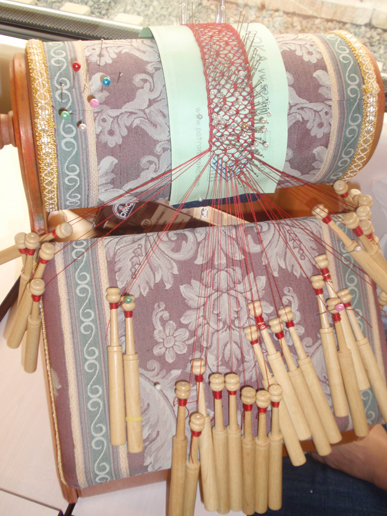
The bobbins on the "Mundillo"
El Encaje de Bolillos (Bobbin Lace) is a textile lace technique, which involves initially weave threads are wound into coils, called "bobbin", for better management. As work progresses, the tissue is held by pins, fixed on a pad, called "Mundillo". The place of the pins is usually determined by a pattern of little holes in the pad.
The lace can be performed with coarse or fine threads. Traditionally, it was made from linen, silk, wool and cotton subsequently. Also with precious metal wire. Today it is also performed with a variety of synthetic fibers, wires or other filaments.
Among the design elements that can be performed there are fabrics (cloth), nets, ropes, nails, boxes and packing, but not all types of bobbin lace include all these elements.
Many types of lace were invented during the heyday of embroidery (approximately between 1500 and 1700) before the automatic embroidery machines were available.
The appearance of the embroidery machine designed by John Heathcoat in 1806 initially spurred the artisans to invent more complicated designs that machines could not perform, but the mechanization left jobless artisans almost completely. The reappearance of embroidery is a recent phenomenon and, in general, is considered a hobby, although there are still guilds that meet regularly in places like Devonshire (England and Orange County (California). During the European peoples where the lace was once a major industry, especially, Belgium, England, Spain and France, the lace still teach their art and sell their goods, but their clientele is no longer the same, nobility richer passed to the curious tourist.

The type of lace "Valenciennes"

Lace of Malinas
In Galice it was also known the bobbin lace. Concretely Camariñas is a village that gave name to the bobbin laces, which were made in all Galice and which come back again.
They used the linen thread, which was grown in Galice (North western Spain) abudantly. In the cathedral of Toledo, in the first half of the sixteenth century, Galician yarn purchases appear, suggesting that exported to the rest of Spain.
Is this a guipure lace type where the leaves are the basic elements of decoration. They are roses, stars, ferns on a background made with twisted lattice virgulitas and sometimes very complex cross forming this tledown or kites.
But also in Almagro (Ciudad Real, South western Madrid, Spain) you can find a very nice and important lace. In the nineteenth century the most important center of lace production in Spain, a variant of lace made of silk thread, stood at Almagro, being very renowned for their blankets. There, a large number of factories manufacturing vied either by the collection of drawings, either by the number, the artistic taste or stippling.
Bobbin lace and lace are a tradition handed down from mother to daughter and well preserved in this town and some other municipalities of Campo de Calatrava, with which even its renowned blankets are made. There is a museum in Almagro Blonda Lace and municipal property.
Well, I hope that you have enjoyed.
Till soon, kind regards,
Luis.
Sponsored by Costaluz Lawyers.
Please click down here:

 0
Like
Published at 12:17 AM Comments (0)
0
Like
Published at 12:17 AM Comments (0)
The Zarzuela in Spain: El Bateo
Wednesday, October 2, 2013
“El Bateo” is a piece of Zarzuela, that is a comic farce, in a ceremony and four tables, written by Antonio Paso and Antonio Dominguez and Music by the Teacher Federico Chueca. It was premiered in November -1901, at the Theatre of the Zarzuela.
Antonio Paso was a prolific author of Zarzuela and Magazines, who became President of the Society of Authors and father of Alfonso Paso, the most prolific author of Theatre, from Lope de Vega. For example: in 1966, 8 theaters in Madrid were representing his works.
Federico Chueca is probably the author who has best capture the people´s soul of Madrid, of the music of Madrid.
Now, we are going to watch the work “El Bateo”:
http://youtu.be/qZ6KpOEAOrM
This is the lyrics, in Spanish:
Él: “Yo me llamo Virginio Lechuga Garcí y Quirós, gracias a Dios y, desde este momento, Señora, soy su servidor y admirador;. Donde sirvo, se presta dinero, sin mas interés….y a fin de mes, por 50 duros tiene usted que dar 1200 Reales al pagar….Estas y otras cosas que el villano proporciona, para dejarle arruinada a una persona, mas si de este modo gasta el capital, veo en un Asilo a mi principal……¡Te he dicho que no!”.
Ellos llaman a Visita (la protagonist de la obra): “¡Visita…!, ¡Visita…!”
Él: “Aquí traigo unas medias de seda color carmesí; pero hasta aquí…, quiera Dios que a Visita le gusten lo mismo que a mí….creo que sí…; de seguro que cuando las vea me va a regañar y a preguntar: ¿para qué hace esto Sr. Vigimín?, Para que se acuerde usted de mí. Cuando se las ponga y el vestido se levante, un poquirritito nada mas que por delante, Valgame San Pedro lo que se veráaaaa!, Dios que me perdone, si es que pienso mal”.
………………………………………………
Llega Visita y dice: “Muy buenos días, Sr. Viginio…”
Virginio: “Muy buenos días los tenga usted…Cuando me mira, me vuelvo loco y me sonrojo.., no sé por qué..”
Now Visita answers to him, but I do not understand what she says…; I am sorry.
Visita: “Yo soy una Chula muy resalá (resalada = charming).”
Virginio: “Olé yaaaa”
Visita: “Soy un granito de primer to….”
Virginio: “Ole yoooo”
Visita: “Todos los hombres cuando me miran, porque suspiran y todos van detrás de mí, porque me traigo vivos hasta allí”
Virginio: “Olé que sí”…”Yo soy un “lila” (lilac ~ gay = homosexual) como usted ve”
Visita: “Ya lo séeee”
Virginio: “Soy un pedazo de requesón”
Visita: “Y un simplón”
Virginio: “Yo me declaro….”
Visita: “Decía usted”
Virginio: “Que hace un dia muy hermosooo…”
Visita: “Y un bochorno de chipén”
Virginio: “No sé qué hacer…eso es atroz…¿Por qué seré tan cobardón??
Visita: “¿Qué tiene usted tan enfadado…, a caso yo le habré faltado?; ¿Qué tiene usted tan enfadado, a caso yo le habre faltado?
Virginio: “Ahora mismo se lo digo y estas tonterías ya se han acabado”………..
….”Estoy…,estoy….”
Ellas: “¡Quéeee!”
Virginio: “Estoy mujer amorao….de una chica muy chulapa, que me trae dislocao…”
Visita: “¿Se pue…..se pue……se puede saber quién es?”
Virginio: “Pues es…, pues es….”
Visita: “Pues hijo…”
Virginio: “Pues es usted”
Now I can not understand well to Visita…., I only understand her when she says: “……..la contestación…….Lo que me ha dicho sera confirmer”
Virginio: “Que me condene si no fuera así”
Visita: “Pues desde hoy lo consentiré y me iré…”
Virginio: “¡Qué felicidad….No sé por qué me han slido del me dan…….Juré que suyo tan sólo seré”
Visita: “Dentro de un rato se lo juraréeee”
Virginio: “Venga esa manoooo”
Visita: “Con el ya va…En cucliyas muy bonito, para andar a bofetás”
Virginio: “Qué fuerza tiene la condenadaaaa…”
Visita: “…………”…”Soy preciosa como un clavel”
Virginio: “Ya lo sé”
Visita: “De…………. a figunoooon, que …..que yo hablaseeee era dueño de mi amor. Vaya un tipel…”
Virginio: “Qué alegre estoy…, yo con usted, qué pillo soy….ay qué trapel…, qué alegre soy….yo con usteeeed……”, at the same time, Visita: “un chupa soy….qué lila es….ay qué simplon……vaya un trapel….mariposón….qué lila es….”
At the end, both say:
Virginio: “Rica”
Visita: “Rico”
Virginio: “Mona”
Visita: “Requetemonín…Uhhh”
Virginio and Visita: “Qué alegreeee sooooooooooooooy”
And this is the lyrics in English:
Him: " My name is Virginio Lechuga García y Quiros , thanks God , and from this moment , Lady, I am your servant and admirer , . Where I serve , lends money without interest .... and more ends meet by 50 reales you do have to give 1200 reales to pay .... These and other things that the villain gives for ruined let a person, but if this capital spending mode , I see in a Nursing Home to my main......I have told you no " .
They call Visita ( the protagonist of the book ) : "Visita ... ! ,Visita ... ! "
Him: " I have brought a crimson silk stockings , but even here ... God forbid you like to visit the same thing to me .... I think so ... ; insurance when I will see scold and ask: what does this Mr. Virgimín ? , you agreed for me. When the set and dress up a poquirritito nothing but ahead , Oh Saint Peter! what it will be seen? , God forgive me , if I wrong".
......................................................
Visita arrives and says, " Good morning , Mr. Virginio ... "
Virginio : " Very good morning you have them ... When I look, I get mad and blush .. I do not know why .. "
Now Visita answers to him , but I do not understand what she says ... , I am sorry .
Visita: "I am a very resalá cocky ( resalada = charming ) . "
Virginio : " Olé alreadyyyy "
Visit: "I am a granite top to .... "
Virginio : " Ole meeeee "
Visita: " All men when they look , because everyone will sigh and behind me , because I bring things up there "
Virginio : " Olé yes " ... " I am a" lilac " ( lilac ~ gay = homosexual) as you see "
Visita: "You will see it "
Virginio : "I'm a piece of cottage cheese "
Visita: " And a simpleton "
Virginio : "I declare .... "
Visita: " You said….."
Virginio : " What does a very beautiful day ... "
Visita: " And an embarrassment Chipen "
Virginio : " I do not know what to do ... that is terrible ... Why am I so cowardly?”.
Visita: " What have you got so angry ..., a case I have I missed? ; What has you so angry….., a case I have missed?”
Virginio : "Right now I say and this nonsense already been finished " ...........
.... "I'm ... I'm .... "
Them (the ladies): "Whaaat? "
Virginio : "I am, woman, amorao (in love, he means).... of a pretty chulapa (cocky woman) , which brings me dislocated ... "
Visita: " ..... May it be? ......May it be ?........ May it be known ? "
Virginio : " Well, it is ... but it is .... "
Visita: " Well son ..."
Virginio : "But it is you "
Now I can not understand well to Visita ...., I only understand her when she says: "........ the answer ....... What I have said will confirmer "
Virginio : " I will be damned if I did not "
Visita: "As from today I will consent and go ... "
Virginio : "What happiness .... do not know why I have slido of give me yours ....... I swore that I will only "
Visita: " In a little while I will swear to you "
Virginio : " Come that hand"
Visita: " With the already it goes ... In crouch down very nice to walk to slaps "
Virginio : " What force has the condemneeeed ... "
Visita: "............" ... "I am beautiful as a carnation "
Virginio : "I know it "
Visita: " Of ............. to figunoooon that I talked ..... I owned my love . What a tipel ... "
Virginio : " How happy I am ... , I with you, I get it .... oh why do Trapel ... what .... I 'm happy with usteeeed ......" , at the same time , visit: " I'm a dick .... what is lilac oh what a simpleton ...... .... go one Trapel .... philandering .... what lila is .... "
At the end , Both say :
Virginio : " Rich "
Visita: " Rich "
Virginio : " Pretty "
Visita: " Requetemonín ... Uhhh "
Virginio and Visita: " What happy I aaaaaaaaam "
This is the story of El Bateo, in a short way:
Baptism (batting) is the child of Nieves and Lolo, whose paternity is questioned by Pamplinas, old love spoiling Nieves proposed baptism, helped by Visita one cocky Lolo infatuated and who wants Virginio, for it spreads the rumor that Nieves house between a man early on the man in question is Wamba but does not seek but his mother Nieves. At the end it all ends with the joy of all, Pamplinas is mocked, Nieves and Lolo are preparing to marry, like Valerian and Wamba. The poor Virginio is paying for the duck blame all of conspiracies.
Well, I hope that you have enjoyied.
Till soon, kind regards,
Luis.
Sponsored by Costaluz Lawyers.
Please click down here:

 0
Like
Published at 2:46 AM Comments (0)
0
Like
Published at 2:46 AM Comments (0)
Spam post or Abuse? Please let us know
|
|